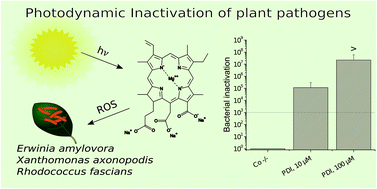Save the crop: Photodynamic Inactivation of plant pathogens I: bacteria†
Abstract
The ever growing world-population poses challenges concerning the need for more food free of pesticide residues. The most common means to control plant pathogens is through the application of pesticides, which raises concerns over safety for humans and the environment. Recently, Photodynamic Inactivation (PDI) of microorganisms using natural photosensitizers has shown itself to be a powerful tool to combat bacteria and fungi. This study investigates the efficacy of PDI against the Gram(+) bacterial plant pathogen Rhodococcus fascians and Gram(−) Xanthomonas axonopodis and Erwinia amylovora using two chlorin e6 derivatives as photosensitizers: anionic sodium magnesium chlorophyllin (Chl, approved as food additive E140) in combination with cell wall permeabilizing agents (Na2EDTA or Polyaspartic acid sodium salt (PA)) and B17-0024, a mixture of chlorin e6 derivatives with cationic moieties at physiological pH. Both photosensitizers show excellent efficacy against R. fascians, whereby B17-0024 is phototoxic at a one order of magnitude lower concentration than Chl (10 μM B17-0024: relative inactivation (r.i.) >7.5 × 106, 100 μM Chl: r.i. 2.2 × 106, illumination with 26.6 J cm−2, 395 nm). The phototreatment of Gram(−) bacteria with Chl requires the obligatory use of cell wall permeabilizing agents like Na2EDTA (X. axonopodis) or PA (E. amylovora) to induce significant killing (more than 7 log units at 100 μM). On the other hand, B17-0024 proves to be a highly effective photosensitizer inducing bacterial inactivation at very low concentrations (10 μM for R. fascians and X. axonopodis, 100 μM for E. amylovora) without additives. In summary, PDI using both the natural photosensitizer Chl in combination with cell wall permeabilizing agents is effective and environmentally friendly. As an alternative, B17-0024 is highly photoactive against all model strains tested – even without cell wall permeabilizing agents. The photodynamic approach based on chlorin e6 derivatives should add to the growers’ toolbox as a preferred alternative for the control of phytopathogens.

- This article is part of the themed collection: New and innovative applications of Photodynamic Inactivation of microorganisms


 Please wait while we load your content...
Please wait while we load your content...